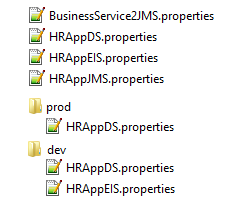createOrUpdateWeblogicConfig
Creates or updates DataSources, EIS entries, JMS objects, and Work Managers as defined by input properties files. The properties files will be processed for property replacement first before execution. See Property Replacement Support for more information about property replacement.
If using multiple files, make sure that the lists contain unique values across files.
Adapter Deployment
This operation will perform the EIS changes using createOrUpdateEISEntries, which will Redeploy Adapter.
To only Save Adapter Plan, use the generateEISDeploymentPlans operation instead of this operation.
To Update Adapter instead, use the updateEISDeploymentPlans operation instead of this operation.
So, if you want save or update the Adapter, then create a workflow containing the desired EIS operation. If you want to process JMS, DataSource, and Work Manager entries in same workflow add those necessary operations in the same workflow.
Blog Posts
- https://flexagon.com/2017/03/automating-the-creation-of-weblogic-configurations/
- https://flexagon.com/2016/11/save-time-and-headache-automate-your-weblogic-data-source-configurations/
- https://flexagon.com/2018/04/yes-you-can-create-weblogic-bridges-reliably-with-flexdeploy/
- https://flexagon.com/2018/04/yes-you-can-create-work-managers-reliably-with-flexdeploy/
If you want to detect changes in WebLogic resource (properties) files and only deploy changed files, you can implement custom workflow as defined in Custom Workflow to detect changes in Properties Files.
Environment/Instance Properties
| Property Name | Property Code | Required | Description |
|---|---|---|---|
| Oracle WebLogic Home (WL_HOME) |
| Yes | WebLogic Home Directory. (e.g. |
| WebLogic Domain Name |
| Yes | WebLogic Domain Name. |
| WebLogic Admin Listen Address |
| Yes | The listener address of the WLS admin server. (e.g. localhost) |
| WebLogic Admin Listen Port |
| Yes | The port of the WLS admin server. (e.g. 7001) |
| WebLogic Admin SSL Connection |
| No | Indicates whether the admin server is using SSL. |
| WebLogic Admin User |
| Yes | The user name for the WLS admin server. |
| WebLogic Admin Password |
| Yes | The password for |
| WebLogic Admin Domain Directory |
| No | Weblogic Domain Directory for AdminServer. If not provided, |
| WebLogic Domain Directory |
| Yes | Weblogic Domain Directory.(e.g. |
| WebLogic Adapter Plan |
| No | Path to the XML files used by Resource Adapters. (optional) If this parameter is not used, the adapters' last-used setting will be used. |
Project Properties
Property Name | Property Code | Required | Description |
|---|---|---|---|
Inputs
| Property Name | Property Code | Required | Description |
|---|---|---|---|
| Properties File Path | FILE_PATH_TO_PROPERTIES | No | Comma-separated list of paths to the properties file(s). |
Outputs
Output Code | Required | Description |
|---|---|---|
FDWLS_OUT_IS_RESTART_REQUIRED | No | A |
Artifacts
This operation consumes properties file artifacts.
Endpoint Selection
This operation will select all available endpoints associated to the environment instance which have a resource type of WLS Admin Server. Since the admin server only runs on one server, it is expected that for a given domain, there will only be one endpoint with a resource type set to WLS Admin Server.
Endpoint Execution
This operation will execute on the Admin Server endpoint selected using the WLS Admin Server resource type.
Special Considerations
If Properties File Path is not specified, the FD_ARTIFACTS_DIR folder will be used. If a relative path is specified, the path will be relative to the FD_ARTIFACTS_DIR directory.
Each DataSource, EIS Adapter plan and JMS Module file is backed up to FD_TEMP_DIR/configbackup before it is modified. As with all files in the endpoint working directory, these files will be saved for 3 days before being deleted.
Example Folder Structure
Properties files can reside in the FD_ARTIFACTS_DIR folder, a sub-folder, or another folder. Properties files with the same names in folders named after environments will override settings in the files in the root folder when the operation is run on servers in that environment.
Environment folders must match the environment code within the FlexDeploy topology.
Properties File Format
Multiple Property lists can be defined in each properties file. They can even hold JMS, DataSources and EIS entries in one file, but it is a best practice to use several files and name them according to their contents. If using multiple files, make sure that the lists contain unique values across files. Best practice would be to use the WebLogic DataSource Name as the list identifier for DataSources. Each properties file must start with one or more lists of elements present in the file. Any number of element types is acceptable in each file, and any number of each type of element is acceptable as well. The properties files will be processed for property replacement using ${{VARIABLE_NAME}} format. See Property Replacement Support for more information about property replacement.
Example Property Files
See the Example properties files in the createOrUpdateDataSources, createOrUpdateJMSEntries, createOrUpdateEISEntries, createOrUpdateWorkManagers operations. Any combination of their files is acceptable.
Related content
- style
